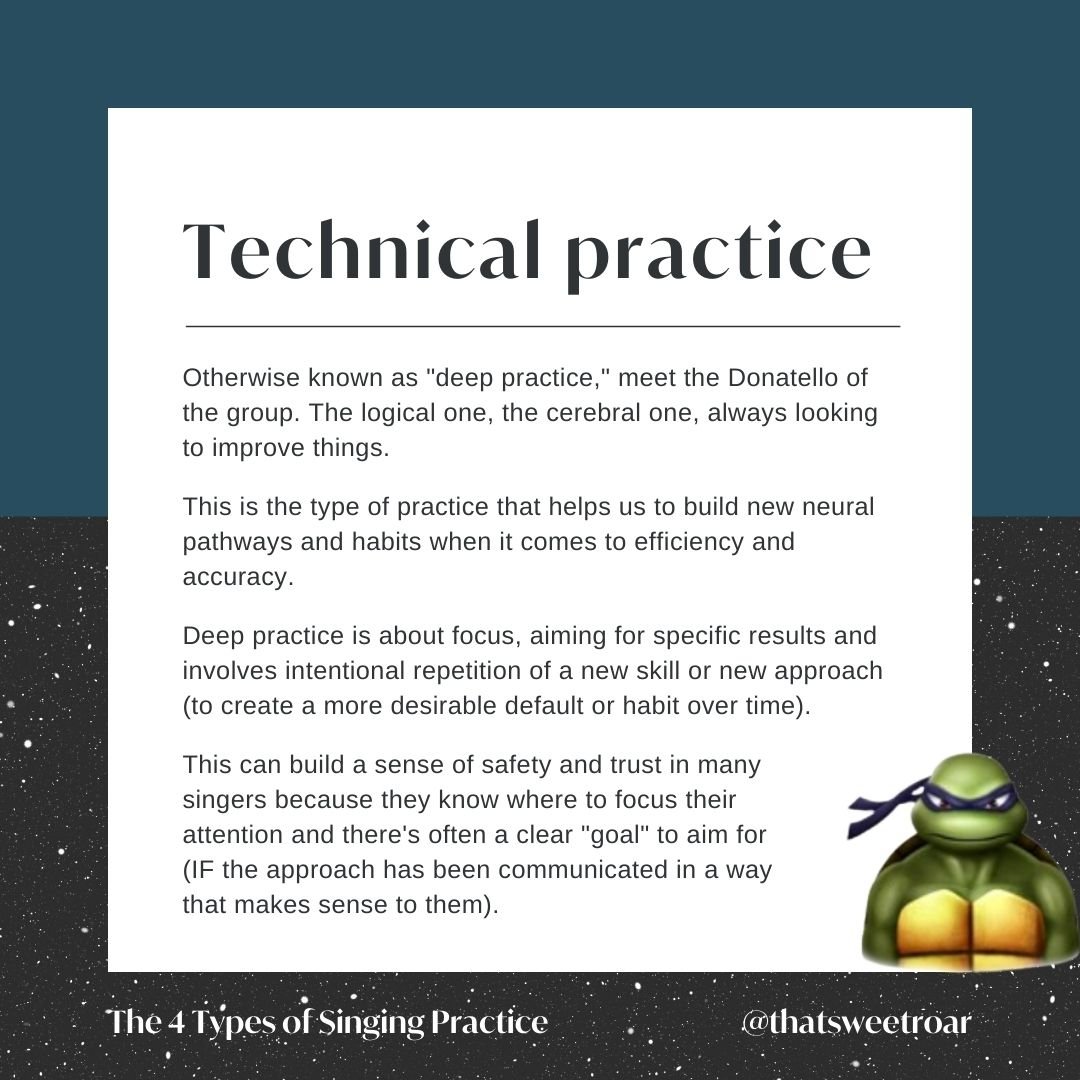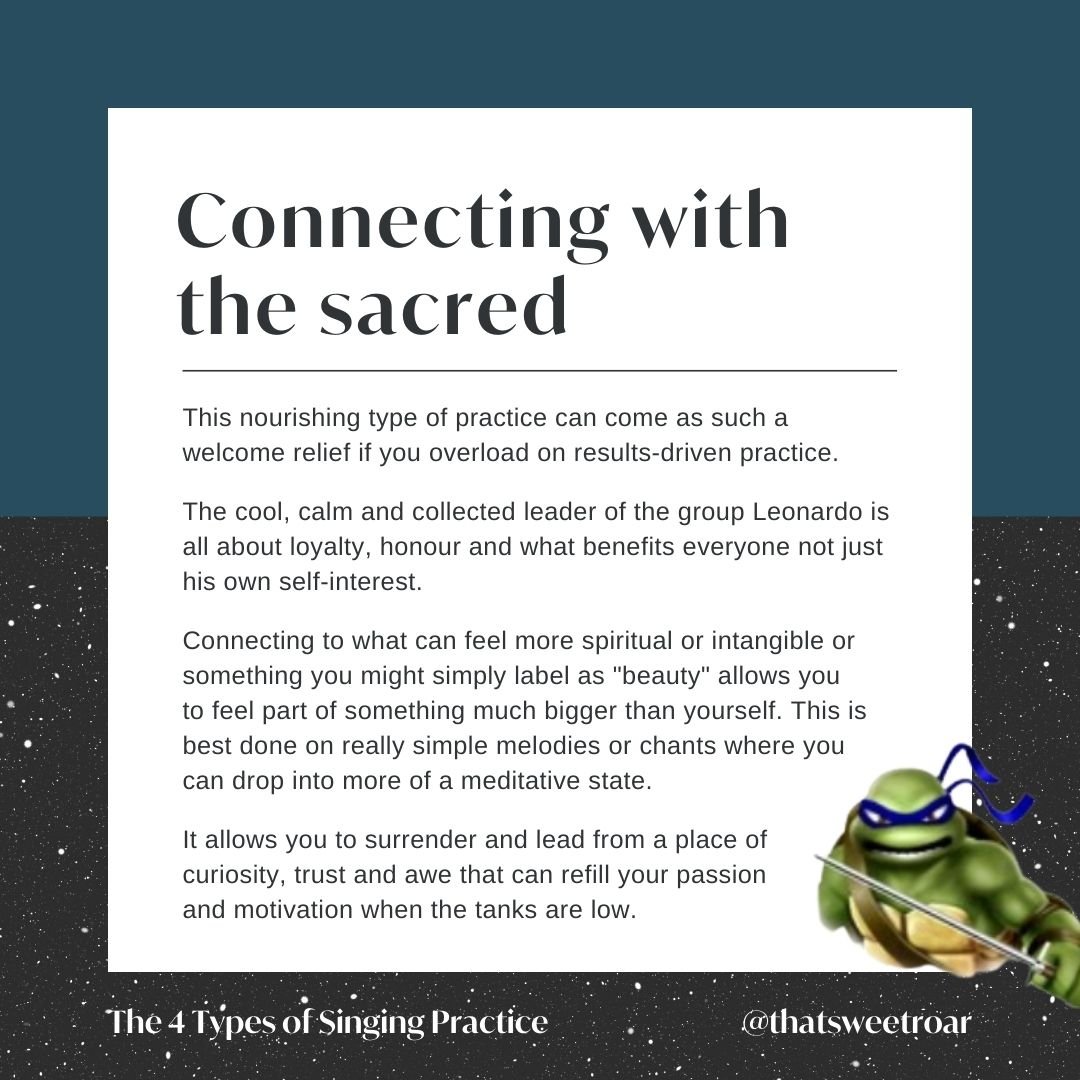How to Practice Singing (The Four Important Types of Practice)
Did you know there are FOUR types of singing practice?
(and they’re all incredibly important when it comes to shaping you as a singer and a performer (and keeping your love for it intact)
Well now you do and I’m going to introduce them to you - with a twist.
You see when I was young, I LOVED the Teenage Mutant Ninja Turtles (I even owned a toy toilet truck) and I figured aligning the types of singing practice with their personalities could add some fun.
Technical practice
(Donatello)
This is the one you’ve probably heard most about (and might tend to prioritise).
The one that teaches your body how to sing with more accuracy, efficiency and consistent tone.
It’s very important that the technique or approach is explained to you in a way that you understand, can replicate and know when it feels right and when it’s not quite there.
Examples of some of my favourite ways to approach technical practice are:
using lip trills, a straw or “motorcycle revs” to make sure my breath is fueling your voice (breath support).
targeting notes in your vocal break by speaking or “exclaiming” them on pitch (to connect your cords in a more organic way).
singing a line all on one word that you loved the tone of (one per line not per note) to show you what vowel shape gives you the colour you’re after.
Incidental practice
(Michelangelo)
When one of my students hangs their head sheepishly and tells me “they haven’t practiced at all this week,” it’s almost always complete BS.
But they say that because they really only count technical practice as “real practice”.
Any time you are singing is practice because you are developing the relationship you have with your voice.
Incidental practice (singing without paying much attention) is actually really important because it’s how you find out how your technical practice is progressing.
Examples of incidental practice you might love to play with:
Singing along to the radio in your car on your way to work or on a roadtrip
Singing while doing chores around the house (laundry, dishes, vacuuming etc)
Singing with kids (along to their favourite songs or singing them to sleep)
Using the acoustics of the bathroom to your advantage (yes there’s a reason shower singing is so popular).
Sacred / spiritual practice
(Leonardo)
This type of practice is not only for those who go to church because ‘sacred’ goes beyond religious expression.
Think of moments where you get lost in the beauty of something or are taken aback in awe - THAT’S what I mean about connecting to the sacred.
And experiencing your voice viscerally is such a beautiful way of doing this (and can become quite meditative and restorative).
Ideas you could explore to experience this for yourself:
Sing something simple with your hands gently touching your throat. Focus on the resonance, the vibrations you can feel in your throat, face and mouth (low notes are going to have the most resonance in your body).
Repeat a simple melody (almost like a chant) and focus on your breath moving in and out.
Close your eyes and hum from low to high and back down again. Follow the resonance moving up and down from your chest/throat up your face.
If you sing in a group (choir or at church or another gathering) close your eyes and let yourself get swept up in the sea of voices around you and what that creates.
Emotional expression practice
(Raphael)
This one is absolutely vital if you really want to express yourself when you perform and MOVE your audience.
Emotional expression practice requires that we switch the logical part of our brain off temporarily (no analysing your sound or thinking about your technique here).
And activate a genuine FELT SENSE of an emotion in the body (this means FEELING elated/hurt/angry, not THINKING ABOUT PORTRAYING that emotion).
A few notes on emotional practice:
This can feel very vulnerable to do so make sure you’re in a space where you feel comfortable to explore where this takes you.
Start with emotions that don’t feel as scary to feel (lighter, happier ones).
Read through the lyrics and figure out what the underlying emotions are that are being written about. You don’t have to have lived the exact experience described, but you can probably recall a time where you’ve felt that way.
If you begin to get overwhelmed by an emotion, bring your attention to the SENSATIONS it activates (tight chest, tingly hands, fluttery heart). It often feel much less overwhelming to be singing with a “heavy feeling in your stomach” VS “grief” (as an example).
I hope you found this post incredibly useful and are excited to spend time with each of the turtles!
If you know you’d like support with…
✨ getting clarity on what techniques/approaches will get you the sound you’re salivating over,
✨ replacing your habit of beating yourself up for your “mistakes” by learning how to get insight from them in a way that helps you course-correct in real-time,
✨ reshaping the way you feel about the process of getting to know, build and appreciate your voice (and your experience of sharing it)
book in for a lesson here!





